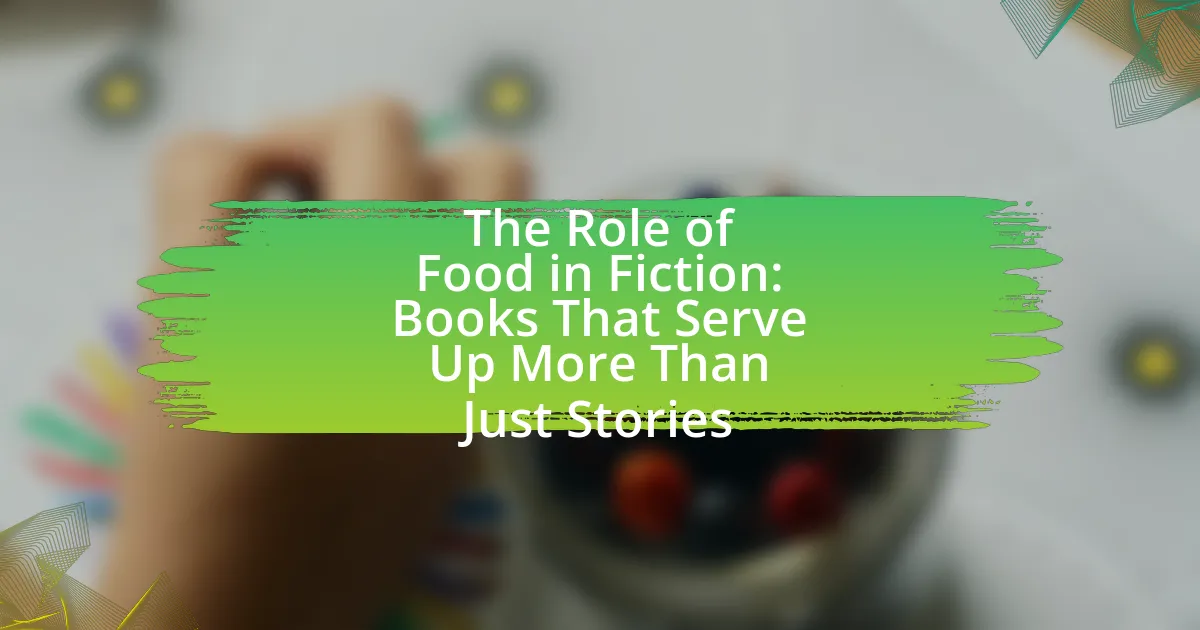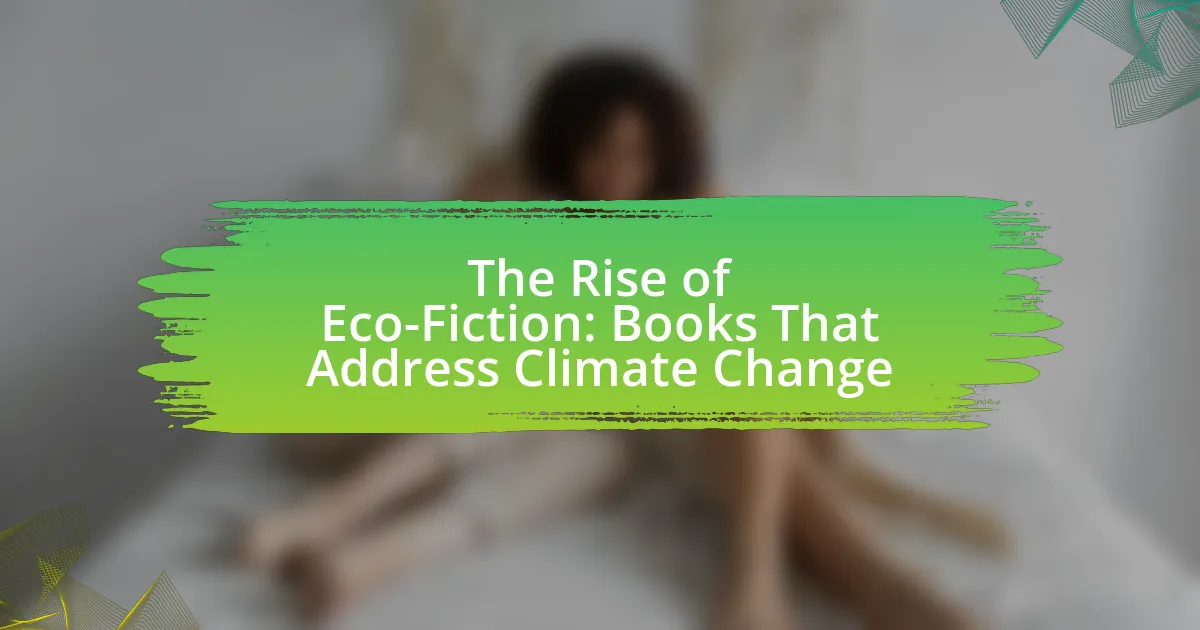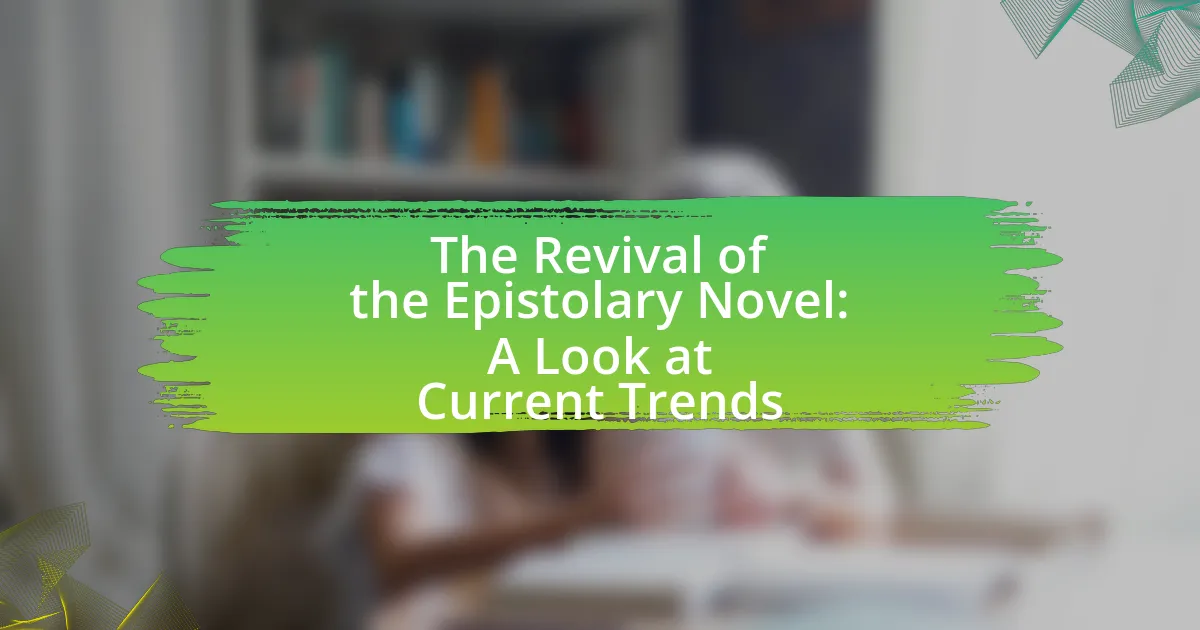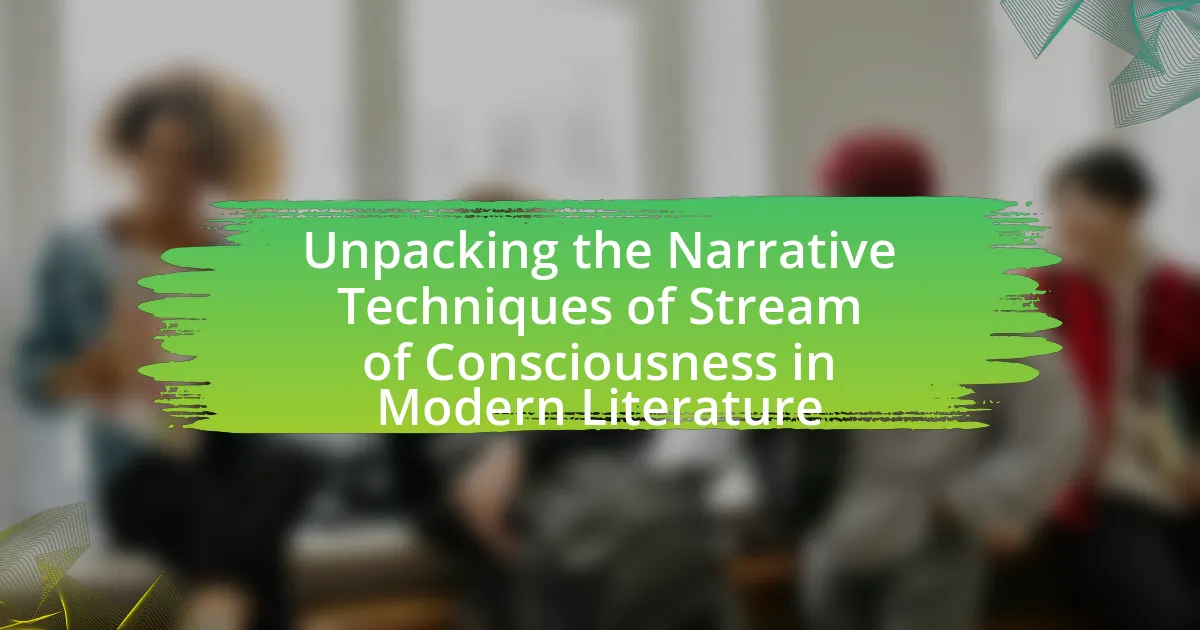Dystopian literature in the 21st century is characterized by its examination of societal anxieties, technological advancements, and environmental issues, reflecting contemporary concerns such as surveillance, authoritarianism, and climate change. The genre has evolved from a focus on oppressive societies to a broader interpretation that includes critiques of social inequality and speculative futures. Key characteristics of modern dystopian narratives include themes of government control, environmental degradation, and the impact of technology on human relationships. Prominent works like “The Hunger Games” and “The Handmaid’s Tale” illustrate these themes, prompting critical discussions about current societal issues and the potential consequences of complacency. Additionally, diverse voices in the genre enrich the narrative landscape, offering insights into systemic inequalities and cultural contexts.
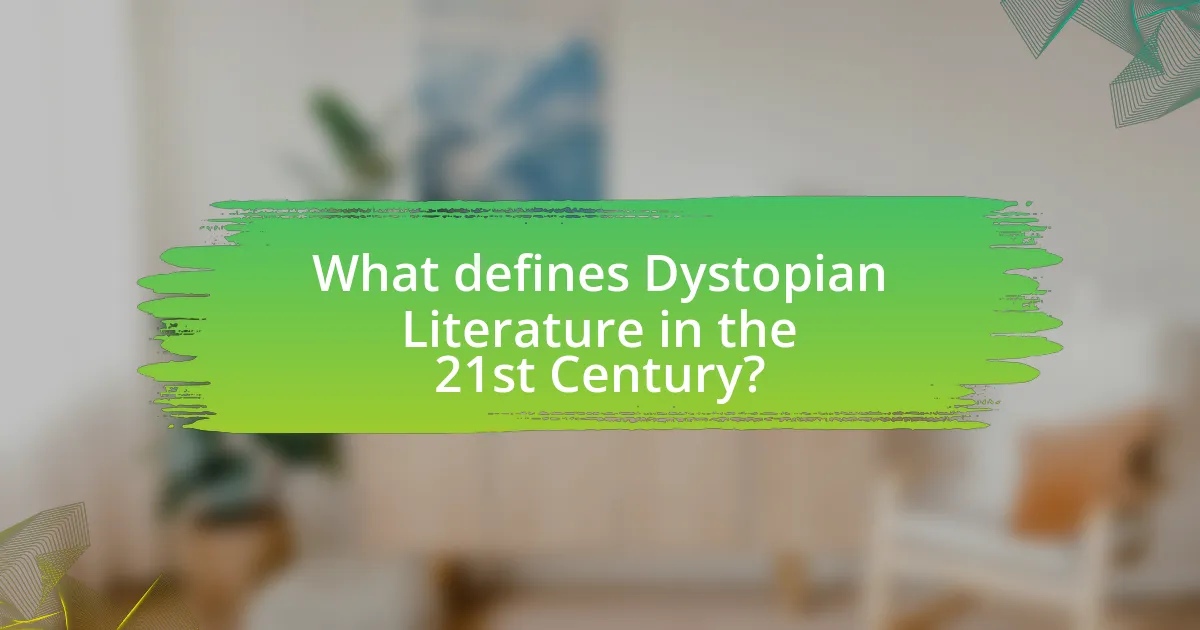
What defines Dystopian Literature in the 21st Century?
Dystopian literature in the 21st century is defined by its exploration of societal anxieties, technological advancements, and environmental concerns. This genre reflects contemporary issues such as surveillance, authoritarianism, and the impact of climate change, often portraying worlds where these elements lead to societal collapse or oppression. Notable examples include “The Hunger Games” by Suzanne Collins, which critiques social inequality and media manipulation, and “The Road” by Cormac McCarthy, which addresses themes of survival in a post-apocalyptic landscape. These works resonate with readers by mirroring real-world fears and uncertainties, thus solidifying their relevance in modern literature.
How has the definition of dystopia evolved over time?
The definition of dystopia has evolved from a focus on oppressive societies in literature to a broader interpretation that includes various societal critiques and speculative futures. Initially, dystopian works like George Orwell’s “1984” and Aldous Huxley’s “Brave New World” depicted totalitarian regimes and loss of individuality, emphasizing the dangers of government control. Over time, the definition expanded to encompass themes of environmental degradation, technological surveillance, and social inequality, as seen in contemporary works like Margaret Atwood’s “The Handmaid’s Tale” and Suzanne Collins’ “The Hunger Games.” This evolution reflects changing societal concerns, illustrating how dystopian literature serves as a mirror to contemporary issues and fears.
What are the key characteristics of 21st-century dystopian literature?
The key characteristics of 21st-century dystopian literature include themes of surveillance, environmental degradation, social inequality, and the impact of technology on human relationships. These narratives often depict societies where authoritarian governments or corporations exert control over individuals, reflecting contemporary anxieties about privacy and freedom. For instance, works like “The Hunger Games” by Suzanne Collins illustrate extreme social stratification and the consequences of a media-saturated culture. Additionally, novels such as “The Road” by Cormac McCarthy highlight the effects of climate change and societal collapse, emphasizing survival in a bleak world. These characteristics resonate with readers as they mirror real-world issues, making the genre relevant and thought-provoking in today’s context.
How do contemporary themes differ from those in earlier dystopian works?
Contemporary themes in dystopian literature differ from those in earlier works primarily by focusing on issues such as climate change, digital surveillance, and social inequality. Earlier dystopian works often centered around totalitarian regimes and nuclear war, reflecting the anxieties of the mid-20th century. For instance, George Orwell’s “1984” and Aldous Huxley’s “Brave New World” emphasized oppressive governments and the loss of individuality. In contrast, modern narratives like “The Hunger Games” by Suzanne Collins and “The Water Knife” by Paolo Bacigalupi address the consequences of environmental degradation and the impact of technology on personal freedoms. This shift reflects a growing concern for global crises and the complexities of modern society, illustrating how contemporary authors respond to current realities rather than solely historical fears.
Why is dystopian literature significant in today’s society?
Dystopian literature is significant in today’s society because it serves as a critical reflection of contemporary issues, such as authoritarianism, environmental degradation, and social inequality. This genre allows readers to explore the consequences of current societal trends and governmental policies, often highlighting the dangers of complacency and the erosion of civil liberties. For instance, works like “The Handmaid’s Tale” by Margaret Atwood and “1984” by George Orwell resonate with current discussions about surveillance and women’s rights, illustrating how fiction can mirror and critique real-world dynamics. Furthermore, the rise of climate fiction, or “cli-fi,” emphasizes the urgent need for environmental awareness, making dystopian narratives relevant as they provoke thought and inspire action regarding pressing global challenges.
What societal issues are reflected in modern dystopian narratives?
Modern dystopian narratives reflect societal issues such as government surveillance, environmental degradation, social inequality, and the erosion of personal freedoms. These themes illustrate the growing concerns about authoritarianism, as seen in works like “1984” by George Orwell, which highlights the dangers of totalitarian regimes and pervasive surveillance. Environmental issues are depicted in narratives like “The Water Knife” by Paolo Bacigalupi, showcasing the consequences of climate change and resource scarcity. Social inequality is a central theme in “The Hunger Games” by Suzanne Collins, where class divisions and systemic oppression are starkly portrayed. Additionally, the erosion of personal freedoms is evident in “Fahrenheit 451” by Ray Bradbury, emphasizing the dangers of censorship and the loss of critical thought. These narratives serve as cautionary tales, reflecting contemporary anxieties and prompting discussions about the future of society.
How does dystopian literature serve as a critique of current events?
Dystopian literature critiques current events by reflecting societal fears and issues through exaggerated, often oppressive settings. For instance, novels like “The Handmaid’s Tale” by Margaret Atwood highlight themes of totalitarianism and gender oppression, paralleling real-world discussions about women’s rights and governmental control. This genre serves as a mirror, allowing readers to examine the consequences of political decisions, environmental degradation, and social inequality, thereby prompting critical reflection on contemporary issues. The portrayal of surveillance in George Orwell’s “1984” resonates with current concerns about privacy and government overreach, illustrating how dystopian narratives can provoke dialogue about the trajectory of society.
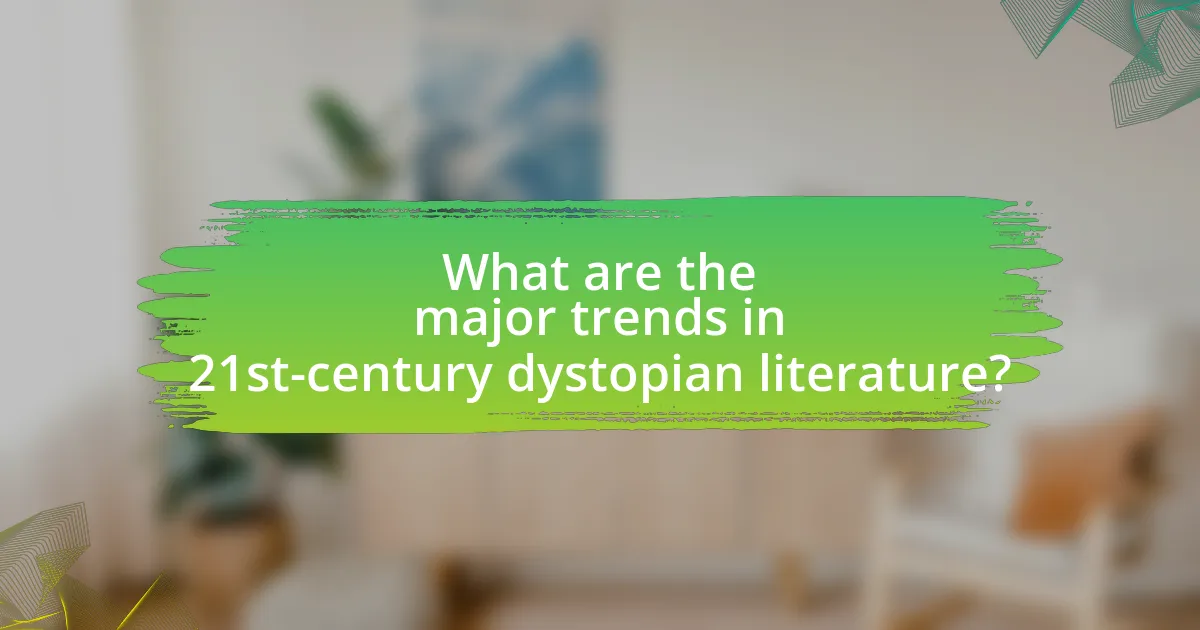
What are the major trends in 21st-century dystopian literature?
Major trends in 21st-century dystopian literature include the exploration of climate change, technological surveillance, and social inequality. Climate change narratives have become prominent, reflecting real-world environmental concerns, as seen in works like “The Water Knife” by Paolo Bacigalupi, which depicts a future ravaged by water scarcity. Technological surveillance is another significant theme, illustrated in novels such as “Little Brother” by Cory Doctorow, where government monitoring raises questions about privacy and freedom. Additionally, social inequality is a recurring motif, with authors like Margaret Atwood in “The Testaments” addressing issues of gender and class disparities in oppressive societies. These trends highlight contemporary anxieties and reflect societal challenges faced in the 21st century.
How have technological advancements influenced dystopian storytelling?
Technological advancements have significantly influenced dystopian storytelling by providing new themes, settings, and conflicts that reflect contemporary societal anxieties. For instance, the rise of artificial intelligence and surveillance technologies has led to narratives that explore issues of privacy, autonomy, and control, as seen in works like “Black Mirror,” which critiques the implications of technology on human relationships and society. Additionally, advancements in biotechnology and genetic engineering have prompted stories that question the ethics of human enhancement and the consequences of playing god, evident in novels like “The Windup Girl” by Paolo Bacigalupi. These narratives often serve as cautionary tales, warning readers about the potential dangers of unchecked technological progress, thereby reinforcing the relevance of dystopian literature in the context of modern technological realities.
What role does social media play in shaping dystopian narratives?
Social media significantly influences the shaping of dystopian narratives by amplifying themes of surveillance, misinformation, and societal division. Platforms like Twitter and Facebook serve as both a medium for storytelling and a reflection of contemporary anxieties, where users often share and engage with content that critiques authoritarianism and technological overreach. For instance, the rise of deepfake technology and data privacy concerns are frequently discussed on social media, mirroring the fears depicted in dystopian works such as “Black Mirror.” This interaction between social media and dystopian narratives not only fosters a community of discourse but also influences the creation and reception of literature, as authors draw inspiration from real-world events and online trends.
How do advancements in artificial intelligence appear in modern dystopian works?
Advancements in artificial intelligence in modern dystopian works often manifest as oppressive surveillance systems, autonomous weaponry, and the erosion of human agency. For instance, in works like “Black Mirror,” AI technologies are depicted as tools for societal control, where algorithms dictate personal choices and relationships, reflecting real-world concerns about data privacy and manipulation. Additionally, novels such as “The Circle” illustrate how AI-driven platforms can lead to a loss of individuality and freedom, mirroring contemporary debates on the impact of technology on personal autonomy. These portrayals serve as cautionary tales, emphasizing the potential dangers of unchecked technological progress and the ethical dilemmas surrounding AI development.
What are the prominent sub-genres of dystopian literature today?
Prominent sub-genres of dystopian literature today include climate fiction, techno-dystopia, and post-apocalyptic narratives. Climate fiction, or “cli-fi,” explores the impacts of climate change on society, exemplified by works like “The Overstory” by Richard Powers. Techno-dystopia focuses on the consequences of advanced technology and surveillance, as seen in “Neuromancer” by William Gibson. Post-apocalyptic narratives depict life after societal collapse, with notable examples such as “The Road” by Cormac McCarthy. These sub-genres reflect contemporary societal concerns and resonate with readers through their exploration of potential futures.
How does climate fiction (cli-fi) fit into the dystopian genre?
Climate fiction (cli-fi) fits into the dystopian genre by depicting futures shaped by climate change, often illustrating societal collapse and environmental degradation. This subgenre explores the consequences of ecological disasters, portraying scenarios where humanity grapples with the fallout of climate inaction, resource scarcity, and social upheaval. For instance, novels like “The Water Knife” by Paolo Bacigalupi present a dystopian vision of a future ravaged by water shortages, highlighting the dire implications of climate change on civilization. Such narratives serve as cautionary tales, emphasizing the urgent need for environmental awareness and action, thus reinforcing cli-fi’s role within the broader dystopian framework.
What distinguishes young adult dystopian literature from adult dystopian works?
Young adult dystopian literature is primarily distinguished from adult dystopian works by its focus on adolescent protagonists and themes of identity, personal growth, and social justice. In young adult dystopian narratives, the characters often navigate their emerging identities within oppressive societies, reflecting the struggles of adolescence, while adult dystopian literature typically explores more complex societal critiques and moral ambiguities. For instance, novels like “The Hunger Games” emphasize youthful rebellion and the quest for agency, whereas adult works like “1984” delve into the intricacies of totalitarianism and existential despair. This distinction highlights the differing target audiences and thematic concerns, with young adult literature often prioritizing hope and resilience in the face of adversity.

How do authors approach themes in 21st-century dystopian literature?
Authors in 21st-century dystopian literature approach themes by reflecting contemporary societal anxieties, such as surveillance, environmental degradation, and authoritarianism. For instance, works like “The Hunger Games” by Suzanne Collins explore themes of class struggle and government control, mirroring real-world issues of inequality and political oppression. Additionally, novels like “The Road” by Cormac McCarthy address themes of survival and human morality in the face of catastrophic events, resonating with current concerns about climate change and societal collapse. These thematic explorations are often grounded in the realities of modern life, making them relevant and thought-provoking for readers.
What common themes are explored in contemporary dystopian novels?
Contemporary dystopian novels commonly explore themes of totalitarianism, environmental degradation, technological control, and social inequality. Totalitarianism is often depicted through oppressive governments that suppress individual freedoms, as seen in works like “1984” by George Orwell. Environmental degradation is highlighted in novels such as “The Water Knife” by Paolo Bacigalupi, where climate change leads to resource scarcity. Technological control is a prevalent theme in “The Circle” by Dave Eggers, illustrating the dangers of surveillance and loss of privacy. Social inequality is examined in “The Hunger Games” by Suzanne Collins, showcasing class divisions and the struggle for survival. These themes reflect societal anxieties and provoke critical discussions about the future.
How do issues of surveillance and privacy manifest in these stories?
Issues of surveillance and privacy manifest in these stories through the depiction of omnipresent monitoring systems that infringe on individual freedoms. In many 21st-century dystopian narratives, characters often navigate environments where their actions, thoughts, and communications are constantly observed by authoritarian regimes or advanced technologies. For instance, in George Orwell’s “1984,” the concept of “Big Brother” exemplifies a society where privacy is obliterated, and citizens are subjected to relentless scrutiny, illustrating the dangers of totalitarian surveillance. Similarly, in works like “The Circle” by Dave Eggers, the normalization of sharing personal information highlights the erosion of privacy in the digital age, reflecting real-world concerns about data collection and the implications of social media. These narratives serve as cautionary tales, emphasizing the potential consequences of unchecked surveillance on personal autonomy and societal structure.
What role does government control play in modern dystopian narratives?
Government control serves as a central theme in modern dystopian narratives, often depicting oppressive regimes that manipulate society through surveillance, censorship, and authoritarian rule. These narratives illustrate how government control can lead to the erosion of individual freedoms and the establishment of a conformist society, as seen in works like George Orwell’s “1984” and Margaret Atwood’s “The Handmaid’s Tale.” In these stories, the government employs tactics such as propaganda and strict laws to maintain power, reflecting real-world concerns about civil liberties and state overreach. The portrayal of government control in these narratives resonates with contemporary audiences, highlighting fears of totalitarianism and the consequences of unchecked authority.
How do diverse voices contribute to the evolution of dystopian literature?
Diverse voices significantly contribute to the evolution of dystopian literature by introducing varied perspectives that challenge traditional narratives. These voices often reflect the experiences and struggles of marginalized groups, thereby enriching the genre with themes of social justice, identity, and resistance. For instance, authors like Octavia Butler and Nnedi Okorafor have incorporated elements of race, gender, and cultural identity into their dystopian worlds, which not only broadens the scope of the genre but also resonates with a wider audience. This inclusion fosters a deeper understanding of societal issues, as seen in Butler’s “Parable of the Sower,” which addresses climate change and systemic inequality. Consequently, the infusion of diverse voices not only enhances the thematic complexity of dystopian literature but also drives its relevance in contemporary discourse.
What perspectives do marginalized authors bring to the genre?
Marginalized authors bring unique perspectives to the genre of dystopian literature by highlighting systemic inequalities and exploring themes of identity, resistance, and survival. Their narratives often reflect lived experiences of oppression, offering insights into how societal structures impact marginalized communities. For instance, authors like Octavia Butler and Nnedi Okorafor incorporate elements of race, gender, and class into their dystopian worlds, challenging dominant narratives and expanding the genre’s scope. This inclusion not only enriches the storytelling but also fosters empathy and understanding among readers, as evidenced by the growing popularity of works that address these critical social issues.
How does cultural context influence the portrayal of dystopian societies?
Cultural context significantly influences the portrayal of dystopian societies by shaping the themes, values, and societal fears reflected in the narratives. For instance, in the wake of events like the September 11 attacks, literature such as “The Hunger Games” by Suzanne Collins illustrates societal control and surveillance, mirroring contemporary anxieties about government overreach and loss of personal freedoms. Similarly, in post-colonial contexts, works like “The Windup Girl” by Paolo Bacigalupi explore themes of environmental degradation and corporate power, reflecting specific cultural concerns about globalization and ecological crises. These examples demonstrate that the cultural backdrop informs the specific elements of dystopian fiction, making it a mirror of societal issues and collective fears at a given time.
What practical insights can readers gain from 21st-century dystopian literature?
Readers can gain insights into societal issues, human behavior, and the consequences of technology from 21st-century dystopian literature. These narratives often reflect contemporary anxieties about surveillance, environmental degradation, and authoritarianism, prompting readers to critically evaluate their own world. For instance, novels like “The Hunger Games” illustrate the dangers of inequality and media manipulation, while “The Road” highlights the fragility of civilization in the face of disaster. Such themes encourage readers to engage with current events and consider the ethical implications of their choices, fostering a deeper understanding of the potential trajectories of society.
How can dystopian literature inspire critical thinking about current societal issues?
Dystopian literature can inspire critical thinking about current societal issues by presenting exaggerated scenarios that reflect real-world problems, prompting readers to analyze and question their own societal norms. For instance, novels like “The Handmaid’s Tale” by Margaret Atwood highlight issues of gender inequality and authoritarianism, encouraging readers to consider the implications of such trends in contemporary society. This genre often serves as a cautionary tale, illustrating the potential consequences of political and social complacency, thereby fostering a deeper understanding of the importance of civic engagement and awareness. By engaging with these narratives, readers can draw parallels between fictional worlds and their realities, enhancing their ability to critically assess current events and societal structures.
What lessons can be learned from the characters’ struggles in these narratives?
The struggles of characters in 21st-century dystopian literature teach the importance of resilience and the human spirit’s capacity to endure adversity. These narratives often depict characters facing oppressive regimes, environmental disasters, or societal collapse, highlighting their determination to fight for freedom and justice. For instance, in works like “The Hunger Games” by Suzanne Collins, Katniss Everdeen’s fight against a totalitarian government illustrates the power of individual agency and collective action in the face of overwhelming odds. Such stories emphasize that hope and solidarity can emerge even in the darkest circumstances, reinforcing the idea that personal and societal change is possible through perseverance and courage.
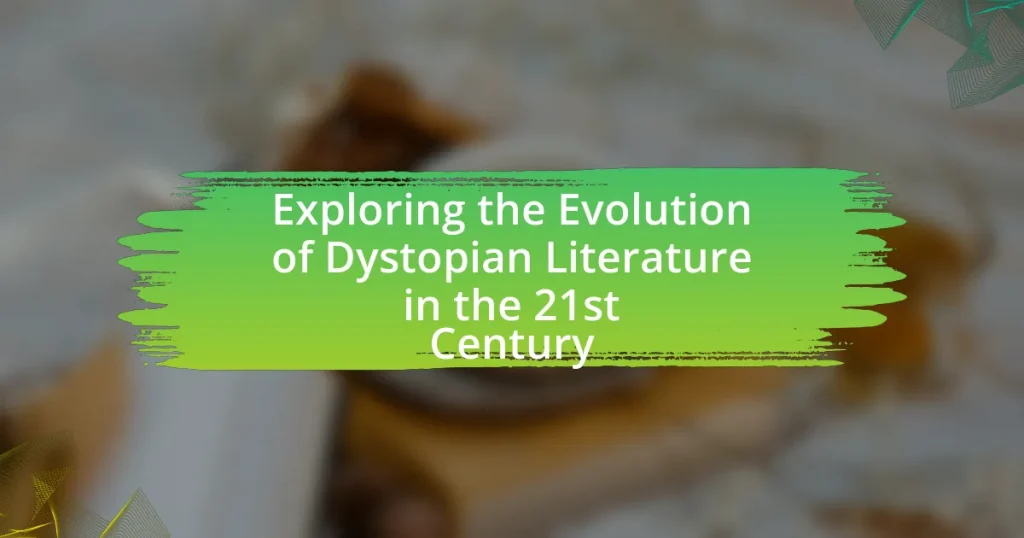

![The Impact of [Author’s Name]’s Cultural Background on Their Writing](https://hotkeyblog.com/wp-content/uploads/Featured-image-The-Impact-of-Authors-Names-Cultural-Background-on-Their-Writing-150x150.webp)
